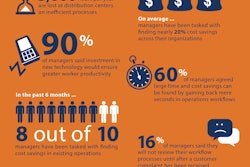
Lean manufacturing is an operating concept with associated strategies and tactics. Its objectives are: 1) an elimination of anything and everything that doesn’t add value to the end-product; and 2) an increase in product quality (or at least the maintenance of a specified level of quality). “Lean manufacturing” is a phrase coined quite recently; even so, the adjective “lean” has since been appended to a variety of services in addition to a variety of disciplines. In regard to the latter, the phrase, lean packaging, has come into vogue. Terminology notwithstanding, packaging historically has pursued lean principles.
Packaging inherently adds value. In fact, packaging is indispensable for the values known as the four utilities: possession, form, time, and place. In other words, packaging allows consumers to possess products, in the desired form, at the consumer’s desired time, and in the consumer’s desired place. Lean principles can’t logically advocate for the elimination of packaging, but can—and should—advocate for the elimination of overpackaging. What constitutes overpackaging can be subjective. That’s why the analysis should be made in an application-specific context; that is to say, the minimum amount of packaging should be utilized in the fulfillment of the requirements of a given application. That packaging philosophy, while completely consistent with the concept of lean, predates its emergence by decades.
Another packaging concept that’s consistent with lean but predates it is the unit load concept, which recognizes that the movement of a quantity in order to get it from point A to point B should be achieved with the least number of handlings, consistent with limitations imposed by material handling equipment, transportation mode, storage conditions, etc. It adds no value to handle a quantity multiple times when the same result can be had with fewer handlings. Packaging has levels: primary (i.e. a bottle), secondary (i.e. a corrugated shipper), and tertiary (i.e. a unit load). It’s unquestionably lean to handle a unit load rather than to individually handle primary packages, or to individually handle secondary packages.
Lean operations share much in common with sustainability, so much so that the objectives of the former can’t be achieved without residual benefits to the latter. It couldn’t be otherwise, since the elimination of waste and the attainment of targeted outputs from the consumption of fewer resources are at the core of both lean and sustainability. The environment has been a factor in the management of packaging and in packaging-related decision-making for decades prior to the introduction of the phrase, sustainable packaging. Both sustainable packaging and lean packaging are latter-day concepts but their defining characteristics have been components of the discipline of packaging for much longer.
For its entire existence, the discipline of packaging has advanced lean principles by increasing quality for the consumer. A packaged product comprises two components—product and packaging—and an increase in the quality of either component increases the quality of the whole, namely the packaged product. Packaging increases quality through its functions: protection, communication, and convenience/utility. All other factors being equal between two competing packaged products, the one that’s better protected is of greater quality. The same is true relative to the packaged product that’s the better communicator, ditto regarding the one that provides the better levels of convenience/utility. The quest to increase quality for the consumer through packaging drives innovations in materials, containers, components, and features. That’s been the case since the birth of the packaging discipline, with competitive pressures having been an ever-increasing constant.
The objectives of lean (eliminating waste and increasing quality) are subject to the variables of time, costs, and efficiency, with emphasis on small, continuous improvements; however, even the most grizzled veterans among us can’t claim to remember a time when the accepted philosophy was to ignore the aforementioned objectives, variables, and improvements. To the contrary, for generations on end, the ability to deliver quality more timely, at less cost, and at greater efficiency has been acknowledged as the path to a competitive advantage. That’s what packaging-related projects have long been about, not only in the picking of the low-hanging fruit, but in efforts that qualify as long-term projects. When a packaging line is configured (or reconfigured) for streamlined operations, that’s an example of lean. When a packaging machine delivers faster speeds, or occupies a smaller footprint, or embodies diagnostics and controls that don’t require a worker who’s highly technical (and more expensive, wage-wise), those, too, are examples of lean.
The objectives of lean, themselves, are not new, but the tools that have become associated with achieving those objectives are newer, at least in name. There have been companies that long have been about rooting out the causes of defects and eliminating them, even if those efforts didn’t go by the name of Six Sigma. There have been companies that long have been about continuous improvements through teamwork, even if those efforts didn’t go by the name of Kaizen. And there have been companies that long have been about optimizing inventory carrying cost, even if those efforts didn’t go by the name of JIT (Just-In-Time). Regarding JIT, it’s packaging’s protective capabilities that allow shipments to go straight from the receiving docks (without inspection or storage) to the plant floor where they are fed into the operations. In short, whatever the lean tool, packaging has to be included, because packaging is such an integrated component of operations, whether we’re talking about manufacturing or processing.
It’s likely that someday the concepts discussed in this article will go by other names (consider how quickly global warming yielded the stage to climate change); but currently, these are lean times. And to any company seeking to be lean without granting packaging a central role, I say, fat chance.
Sterling Anthony is a consultant, specializing in the strategic use of marketing, logistics, and packaging. His contact information is: 100 Renaissance Center- P.O. Box 43176; Detroit, MI 48243; 313-531-1875 office; 313-531-1972 fax; [email protected]; www.pkgconsultant.com























